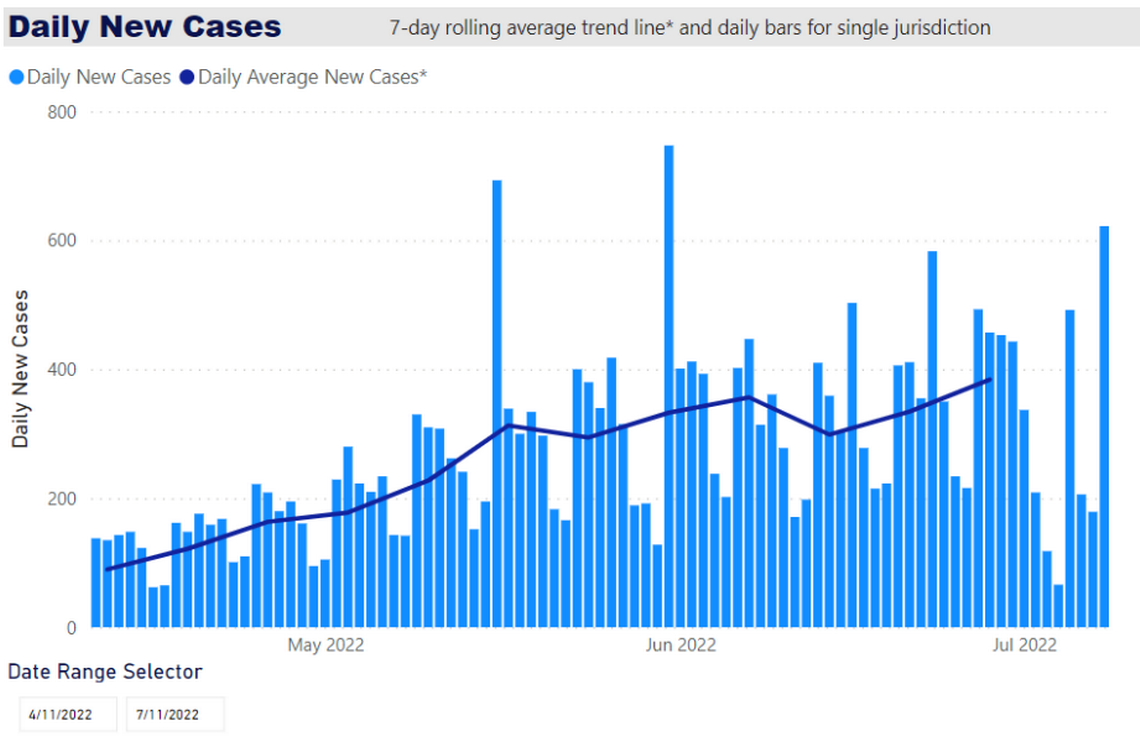The new BA.5 variant is reinfecting Kansas Citians who have had COVID before. Here’s why
A new subvariant of the COVID-19 virus has become the dominant strain in the U.S., and cases are on the rise in Kansas City because of it.
The BA.5 strain is a version of the omicron variant, which caused a significant spike in cases around the country this past winter. While case numbers and hospitalizations are still significantly lower than during the original omicron wave, Kansas City doctors warn that the risk of catching this virus in public is higher than it was a few months ago.
How prevalent is BA.5 in the Kansas City area?
“BA.5 appears to be the dominant lineage in the Kansas City area,” researcher Marc Johnson told The Star. Johnson runs a genetic sequencing lab at The University of Missouri that identifies viral strains in wastewater samples from around the state.
The variant has also gained dominance beyond the metro. According to CDC data, BA.5 is causing an estimated 56.4% of COVID cases in the federal Health and Human Services region that includes Kansas, Missouri, Iowa and Nebraska. That’s even higher than the variant’s nation-wide share of 53.6% of cases.
As the variant takes hold, the Kansas City metro area is experiencing the highest reported number of new COVID-19 cases since the end of the omicron variant wave. In the past week, local counties reported nearly 450 new cases per day on average—a number that is likely significantly lower than the true case count because of the prevalence of at home tests that are not recorded in public data.

Is BA.5 more dangerous than previous omicron variants?
A lot is still unknown about the BA.5 strain, but Yale Medicine reports that the variant may be able to better evade the antibodies caused by previous infection or by vaccines.
This means that it could be easier to be infected by this variant even if you’ve had COVID-19 recently, and built up immunity in your body may not prevent infection. However, this does not necessarily mean that BA.5 is more severe or deadly than previous strains.
“The bottom line is that this new variant remains really consistent with clinical characteristics, in general, compared to other variants,” said Dr. Dana Hawkinson, the University of Kansas Health System’s medical director of infection prevention and control, in an emailed message to The Star. That means that BA.5 causes similar symptoms to the original omicron, at a similar severity.
“We have seen fairly high rates of virus transmission these past couple of months, yet we haven’t seen the commensurate rise in hospitalization and death like we saw with previous waves,” Hawkinson added. “Much of that is due to our individual immunity we have garnered, most safely, through vaccination.”
The University of Kansas Health System is treating 26 patients with active COVID-19 infections as of Monday, July 11. Three of these patients are in the ICU, and two are on ventilators. That’s a slightly higher patient count than reported on Friday.
How can I stay safe during the latest pandemic wave?
The same guidelines that experts have recommended throughout the pandemic remain in effect: wearing a mask in public, washing your hands, attending events outdoors when possible, avoiding large gatherings and getting vaccinated as well as a booster shot are all important steps to remaining healthy.
“The most important thing to remember is that our current vaccines still provide good immunity and remain effective at lowering our risk of hospitalization, severe disease and death,” Hawkinson said. So even if the new variant is infecting vaccinated people, the vaccine lowers the risk of the virus making those people severely sick or in need of hospitalization.
“It remains vitally important to be up-to-date with your COVID-19 vaccination, and if you have symptoms, test early, and get started on Paxlovid if you are at risk of progression to hospitalization,” Hawkinson said.
Here’s what to know if you recently caught COVID-19 for the first time, and here’s how doctors around Kansas City decide when to prescribe Paxlovid.
Do you have more questions about the BA.5 subvariant? Ask the Service Journalism team at kcq@kcstar.com.
